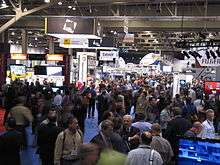National Association of Broadcasters

The National Association of Broadcasters (NAB) is a trade association and lobby group representing the interests of commercial and non-commercial over-the-air radio and television broadcasters in the United States. The NAB represents more than 8,300 terrestrial radio and television stations as well as broadcast networks.
As of 2015, the president and CEO of the NAB is Gordon Smith, a former United States Senator from Oregon.[1]
Founding
The NAB was founded originally as the National Association of Radio Broadcasters (NARB) in 1922 at the Drake Hotel in Chicago. The association's founder and first president was Eugene F. McDonald Jr., who also launched the Zenith corporation. In 1951 it changed its name to the National Association of Radio and Television Broadcasters (NARTB) to include the television industry. In 1958 it adopted its current name, National Association of Broadcasters.[2]
Commercial radio
The NAB worked to establish a commercial radio system in the United States. The system was set up in August 1928 with the establishment of General Order 40—a radio reallocation scheme by the Federal Radio Commission which awarded the choicest frequencies and broadcast times to the then-emerging commercial radio industry. In the wake of General Order 40, a loose coalition of educators, nonprofit broadcasters, labor unions, and religious groups coalesced to oppose the NAB and their allies through the 1920s and 1930s, and to develop a public, nonprofit, license-funded radio system without commercials (similar to what happened with the BBC). The coalition claimed that the commercial industry would only promote profitable programming, thereby reducing the quality and future potential of radio broadcasting.
Not having the political connections, resources, or publicity of the NAB and the commercial radio industry, the non-profit coalition eventually lost the fight with the passage of the Communications Act of 1934.[3]
The National Independent Broadcasters were formed in 1939 as part of the NAB, to represent stations that were not associated with any network, but the group split off in 1941.[4][5]
Satellite radio
Many satellite radio enthusiasts have criticized the NAB for lobbying against legislation approvals for those services. The NAB protested the FCC's approval of both satellite radio services in the United States—XM and Sirius—and furthermore criticized the 2008 merger of the two companies, calling the merged company a "potential monopoly".[6]
White space
The NAB has lobbied against the use of white spaces, unused broadcast spectrum lying between broadcast channels, for wireless broadband internet and other digital use. The NAB has claimed that use of white space will interfere with existing broadcast spectrum, even though tests by the Federal Communications Commission at levels far stronger than that being advocated for in policy circles have not supported such claims.[7] Indeed, the FCC has recommended the use of white spaces for broadband and other digital use.[8] In 2011 the NAB funded an advertising campaign titled "The Future of TV",[9] advocating for the private ownership of the spectrum, framed as a threat to free television.
Free TV campaign
In mid-2014, an NAB advertising campaign against a Congressional threat appeared, advocating viewers to defeat a cable-TV lobby.[10][11]
Similar organizations
Organization similar to the NAB exist in individual U.S. states, including Georgia Association of Broadcasters (GAB) in Georgia, and the Illinois Broadcasters Association (IBA), in Illinois. In Canada, the Canadian Association of Broadcasters (CAB) has a similar role.
Gatherings

NAB's annual spring convention is the NAB Show. It typically draws over 100,000 industry professionals.[12] NAB also manages the NAB Radio Show which is held each autumn and draws over 3,000 radio professionals. At the 2010 and 2011 NAB shows, popular technology included stereoscopic video and editing software—a demand inspired by James Cameron's Avatar; point-of-view cameras, and DSLR cameras boasting shallow Depth of Field. Other strides in nonlinear editing technology included archival film restoration, digital audio mixing improvements, motion stabilization of hand-held footage and rotoscoping with one click.
Notable NAB Broadcasting Hall of Fame inductees
| Year | Television | Radio |
|---|---|---|
| 2000 | Saturday Night Live | Tom Joyner |
| 2001 | Ted Koppel | "Cousin Brucie" Bruce Morrow |
| 2002 | Rowan and Martin's Laugh-In | Dick Orkin |
| 2003 | Walt Disney anthology television series | Scott Shannon |
| 2004 | Roger King | Mormon Tabernacle Choir "Music and the Spoken Word" |
| 2005 | The Tonight Show | Jack Buck |
| 2006 | Regis Philbin | Dick Purtan |
| 2007 | Meet the Press | Rick Dees |
| 2008 | Bob Barker | Larry Lujack |
NAB awards
The NAB presents several annual awards:
- NAB Marconi Radio Awards, to the country's top radio stations and personalities
- NAB National Radio Award, to an outstanding individual leader in the radio industry
- NAB Crystal Radio Awards, to radio stations achieving excellence in community service
See also
- Code of Practices for Television Broadcasters—includes the NAB's Television Code and Seal of Good Practice
References
- ↑ 18 September 2009 "NAB NAMES GORDON SMITH NEW PRESIDENT AND CEO" NAB.org
- ↑ National Association of Broadcasters
- ↑ "The Battle for the U.S. Airwaves, 1928-1935", in The Political Economy of Media: Enduring Issues, Emerging Dilemmas by Robert W. McChesney (New York: Monthly Review Press, 2008).
- ↑ "N.I.B. Votes to Form Own Organization". Schenectady Gazette. Associated Press. September 24, 1941. p. 2.
- ↑ "Independents Act to Break N.A.B. Tie". The New York Times. September 24, 1941.
- ↑ 28 February 2007 testimony of NAB President David Rehr before US House Judiciary Committee Antitrust Task Force
- ↑ Tim Karr, "The NAB vs. Reality"
- ↑ Megan Tady, "A Win for White Spaces"
- ↑ "The Future of TV"
- ↑
- ↑
- ↑ The NAB Show website